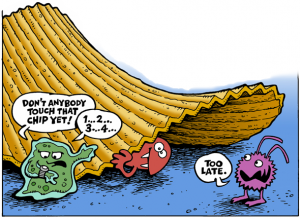
Also the three second, eight second, and you name the number rule. No kidding.
So why is it a bunch of baloney that when you drop a slice of bologna on the floor as you are making a sandwich for lunch, even if you reclaim it right away — certainly in three or five seconds, it still may be crawling with organisms by the time it nestles between slices of bread?
What Is The Five Second Rule?
Although not inscribed in stone, in general terms the five second rule means that if food falls on the floor you can safely eat it if you pick it up within five seconds. There are a whole bunch of variations having to do with the length of time the food remains on the floor. I remember one of my son’s college hockey teammates firmly holding to an eight second rule – as he snatched a post-game French fry off of the rink’s snack bar floor. Have you ever closely looked at the floors in a hockey rink? Even the seasoned coach turned green.
A Zero Second Rule?
A food scientist and his students at the food science and human nutrition department at Clemson University set out to determine if the rule has some validity or if it’s just a bunch of bunk. Horror of horrors, they found that bacteria are transferred from tabletops and floors to food in five seconds and that the five second rule doesn’t apply when it comes to eating food that has fallen on the floor.
Making a strong case for a zero second rule, they found that salmonella and other bacteria can live up to four weeks on dry surfaces and that they are immediately transferred to food.
Location, Location: The Sidewalk Is Better Than The Kitchen Floor
Their findings are in conflict with previous research by Connecticut College students who scattered apple slices and Skittles on the dining hall and snack bar floors and let them reside there for five, 10, 30, and 60 seconds. The apple slices picked up bacteria after one minute and nearly five minutes scooted by before the Skittles became contaminated.
Most researchers agree the important thing is not how long food takes a vacation on the floor, but where that stay is. Believe it or not, according to a professor of microbiology and pediatric infectious diseases at the University of Colorado School of Medicine and author of Germ Proof Your Kids, it may be okay to brush off and give back the gummed up bagel that your kid tossed out of the stroller. Pavement has fewer types of germs that cause illnesses than the kitchen floor which is probably laden with health hazardous bacteria from uncooked meat and chicken juices.
SocialDieter Tip:
A universally applied five second rule for dropped food is bogus. Food can get contaminated with health hazardous bacteria very quickly. There is some dropped food wiggle room depending mostly on where the dropped food lands. Amazingly, food dropped outside, as long as it has dropped on pavement or blacktop rather than on the soil in a chicken coop or an animal pasture, is generally safer than food dumped on your kitchen floor.
And, FYI:
- 100 billion: bacteria in our mouths
- 100 trillion: bacteria in our gastrointestinal tracts
- 2.5 billion: bacteria found in one gram of garden soil
- 7.2 billion: germs in the average kitchen sponge
- 25,000: germs per square inch on an office telephone
- 49: germs per square inch on a toilet seat

Leave a Reply